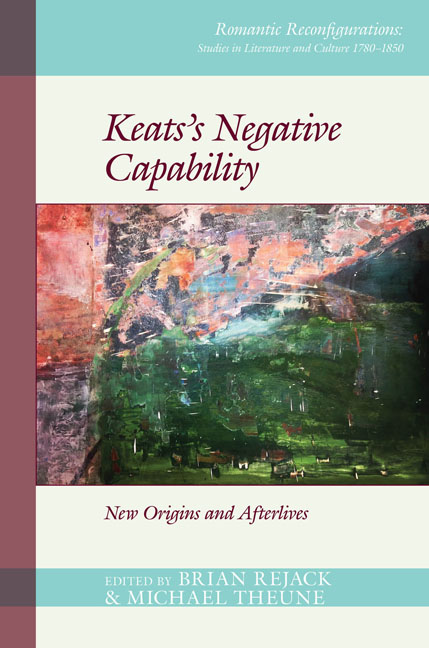Book contents
- Frontmatter
- Contents
- List of Figures
- Acknowledgments
- List of Abbreviations
- List of Contributors
- Preface
- Introduction: Disquisitions: Reading Negative Capability, 1817–2017
- Part I ‘swelling into reality’: New Contexts for Negative Capability
- Part II ‘examplified throughout’: Forms of Negatively Capable Reading
- Part III ‘pursued through Volumes’, Volume I: Negative Capability in Twentieth- and Twenty-First-Century American Poetry
- Part IV ‘pursued through Volumes’, Volume II: Adaptations, Appropriations, Mutations
- Afterword: Reading Keats's Negative Capability
- Bibliography
- Index
1 - Keats's Negative Capability: On Pantomime and ‘Irritable Reaching’
- Frontmatter
- Contents
- List of Figures
- Acknowledgments
- List of Abbreviations
- List of Contributors
- Preface
- Introduction: Disquisitions: Reading Negative Capability, 1817–2017
- Part I ‘swelling into reality’: New Contexts for Negative Capability
- Part II ‘examplified throughout’: Forms of Negatively Capable Reading
- Part III ‘pursued through Volumes’, Volume I: Negative Capability in Twentieth- and Twenty-First-Century American Poetry
- Part IV ‘pursued through Volumes’, Volume II: Adaptations, Appropriations, Mutations
- Afterword: Reading Keats's Negative Capability
- Bibliography
- Index
Summary
Brown and Dilke walked with me & back from the Christmas pantomime.
— LJK, I: p. 193This sentence, which directly precedes Keats's description of his negative capability epiphany, has been often overlooked by Keats scholars. Most notably, Walter Jackson Bate's touchstone ‘Negative Capability’ chapter in his John Keats biography (1963) only briefly mentions Keats's walk back from the Christmas pantomime before quoting and closely scrutinizing the ‘famous sentences’ from Keats's letter. Li Ou's Keats and Negative Capability (2009)—the only twentieth-first-century monograph devoted solely to Keats's concept—does not include this Christmas pantomime sentence in her opening block quotation from Keats's letter, which presents the ‘idea itself’ and serves as the ‘basic reference point of the ensuing discussion’. Harry Beaudry—one of the few scholars who has commented on Keats's pantomime viewing—belittles that particular Christmas pantomime in The English Theatre and John Keats (1973) and offers a bemused explanation of why Keats would precede his negative capability remarks with a sentence about pantomime:
it is a most incongruous circumstance that following this innocuous bit of stage fare Keats and Dilke should become involved in a serious discussion of Shakespeare's ‘negative capability’. One can only reflect that Keats's imagination worked in startling paradoxes at times and could make poetic sense out of incongruity.
Far from an ‘incongruous circumstance’ of Keats ‘at times’ exercising the extremity of his ‘poetic sense’, I argue that pantomime's presence in a ‘serious discussion of Shakespeare’ reveals a fundamental aspect of Keats's negative capability that has yet to be explored. Moreover, Beaudry's disparaging remarks about pantomime implicitly uphold a general critical consensus, reified fortyfive years later in Li's book, that Keats's negative capability should be regarded as a highly serious philosophical endeavor that leans toward a tragic poetic vision. As a result of this longstanding perception, critical definitions of negative capability have not entertained how pantomime—the most popular form of Regency theater—influenced Keats's thinking about his poetic identity and poetics. Spotlighting pantomime's significant role in Keats's concept reveals how negative capability involves playfulness, satire, bodily performance, and popular culture.
The pantomime Keats saw that December 1817 night was Drury Lane’s Harlequin's Vision; Or, The Feast of the Statue (also billed as Harlequin Libertine). In his book Satire and Romanticism (2000), Steven Jones notes that Keats's thinking about negative capability might be connected meaningfully with his experience watching that pantomime.
- Type
- Chapter
- Information
- Keats's Negative CapabilityNew Origins and Afterlives, pp. 15 - 30Publisher: Liverpool University PressPrint publication year: 2019

